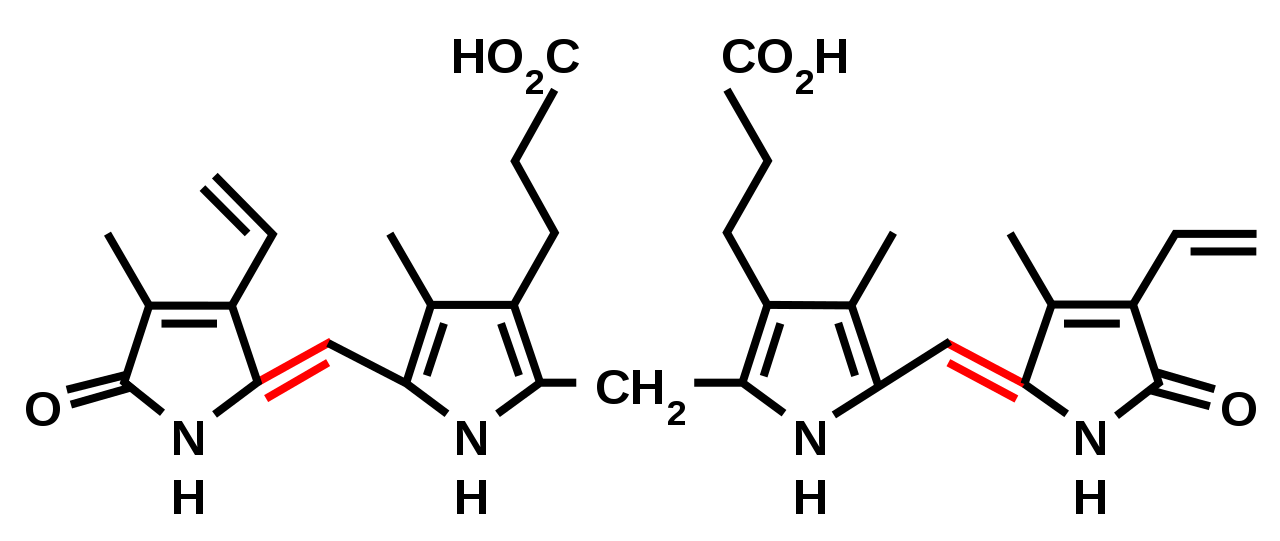The key difference between bile salts and bile pigments is that bile salts are a primary component of bile made from the conjugation of bile acids with potassium ion or sodium ion, while bile pigments are a primary component of bile made by the decomposition of the porphyrin ring.
Bile is a fluid made and released by the liver and stored in the gallbladder. It normally helps with digestion. Bile breaks down the fats into fatty acids. These fatty acids can be taken into the body by the digestive tract. The bile contains 98 % of water, 0.7 % of bile salts, 0.2 % of bilirubin (bile pigments), 0.51 % fats, and 200 meq/l of inorganic salts. Therefore, bile salts and bile pigments are two primary components of bile.
CONTENTS
1. Overview and Key Difference
2. What are Bile Salts
3. What are Bile Pigments
4. Similarities – Bile Salts and Bile Pigments
5. Bile Salts vs Bile Pigments in Tabular Form
6. Summary – Bile Salts vs Bile Pigments
What are Bile Salts?
Bile salts are a central component of bile made from the conjugation of bile acids with potassium ions and sodium ions. Bile acids are made by hepatocyte cells in the liver. These bile acids are derived from cholesterol. Bile salts are similar to bile acids. Bile salts are formed when bile acids bond to molecules of potassium or sodium. All bile salts consist of cholesterol-derived bile acid bound to potassium or sodium ions. Some primary bile salts are changed by intestinal bacteria by removing atoms. This creates what is known as secondary bile salts. Moreover, other bile salts conjugate with amino acids such as taurine and glycine to create conjugated bile salts.

Figure 01: Bile Salts
The main role of bile and bile salts in the body is to aid digestion by breaking down fats, help absorb fat-soluble vitamins, and eliminate waste products. Furthermore, if the body does not produce enough bile salts due to conditions like gall bladder removal, a person may experience complications like diarrhoea, trapped gas, bad smelling gas, stomach cramps, erratic bowel movements, weight loss, and pale coloured stools.
What are Bile Pigments?
Bile pigments are a primary component of bile made by the decomposition of the porphyrin ring. They are also known as bilins or biplanes. Bile pigments are biological pigments in many organisms. They are metabolic by-products of certain porphyrins. Normally, bile pigments are found in many organisms, including mammals, vertebrates, invertebrates, red algae, green plants, and cyanobacteria.

Figure 02: Bile Pigments
In humans, they are coloured compounds and break down products of the blood pigment haemoglobin that are excreted in the bile. The two most important bile pigments are bilirubin, which is orange or yellow in colour, and biliverdin (oxidized form), which is green in colour. Furthermore, mixed with the intestinal contents, bile pigments give a brown colour to faeces (urobilinogen).
What are the Similarities Between Bile Salts and Bile Pigments?
- Bile salts and bile pigments are two primary components of bile.
- Both components are secreted by the liver and pass to the gallbladder.
- They play important roles in the human body.
What is the Difference Between Bile Salts and Bile Pigments?
Bile salts are a primary component of bile made from the conjugation of bile acids with potassium ion or sodium ion, while bile pigments are a primary component of bile made by the decomposition of the porphyrin ring. Thus, this is the key difference between bile salts and bile pigments. Furthermore, bile contains 0.7% of bile salts and 0.2% of bile pigments.
The below infographic presents the differences between bile salts and bile pigments in tabular form for side-by-side comparison.
Summary – Bile Salts vs Bile Pigments
Bile facilitates digestion and contains water, bile salts, bilirubin (bile pigments), fats, and inorganic salts. Bile salts are a primary component of bile made from the conjugation of bile acids with potassium ion or sodium ion, while bile pigments are a primary component of bile made by the decomposition of the porphyrin ring. So, this is the key difference between bile salts and bile pigments.
Reference:
1. “Bile Pigment.” Encyclopædia Britannica, Encyclopædia Britannica, Inc.
2. Young, Becky. “Bile Salts in Your Body: Function, Benefits, and More.” Healthline, Healthline Media, 16 June 2018.
Image Courtesy:
1. “Lipid and bile salts” By Bile1.png: Frank Boumphrey, MDderivative work: Rehua (talk) – This file was derived from: Bile1.png: (CC BY-SA 3.0) via Commons Wikimedia
2. “Bilirubin ZZ” By Stefcho2 – PNG to Vector File:Bilirubin_ZZ.png (CC0) via Commons Wikimedia
ncG1vNJzZmivp6x7pbXFn5yrnZ6YsqOx07CcnqZemLyue9ahmK1lmah6tbTEZpuinpaav6a6wp5km52krLKmuoyboKWdXaiurcDSZpinnF2Xtq2xjKmgoKWVo8G0ew%3D%3D